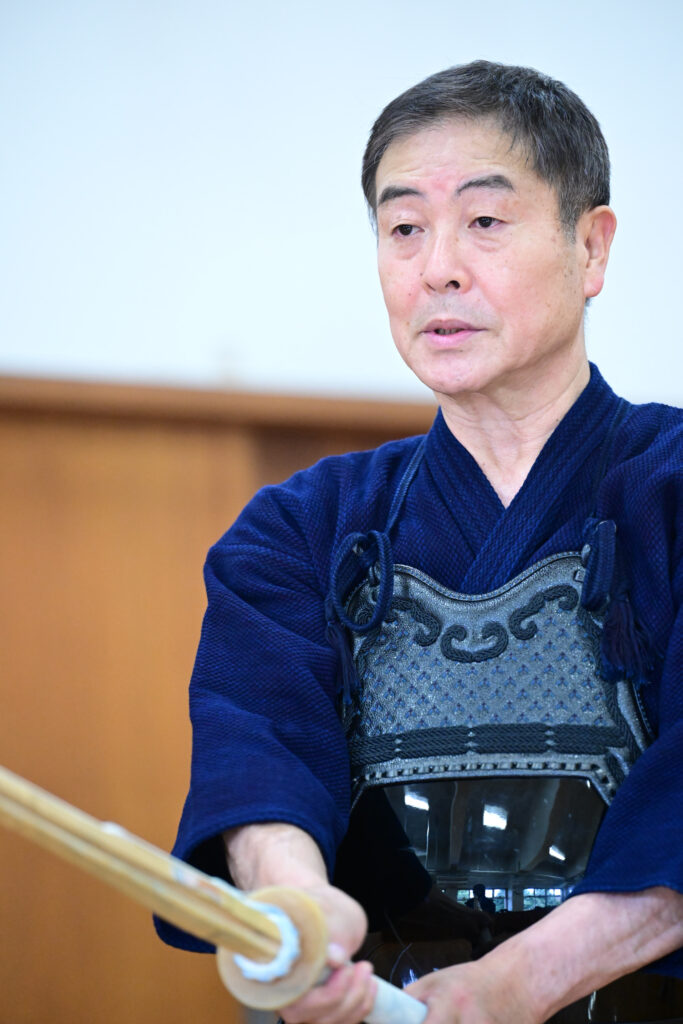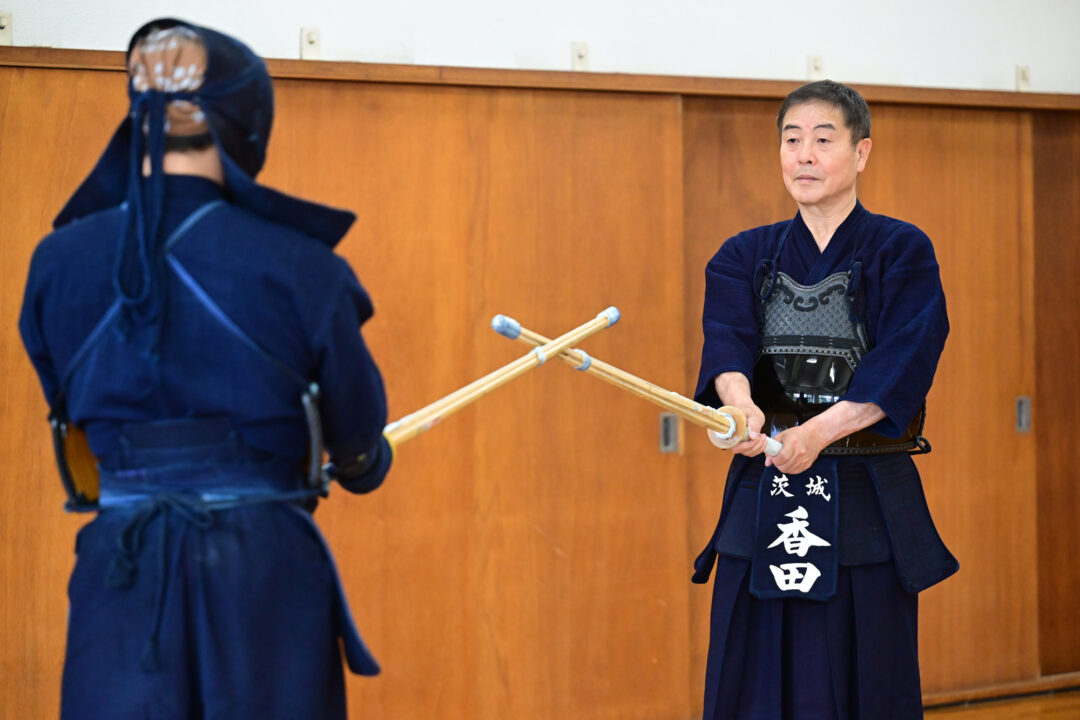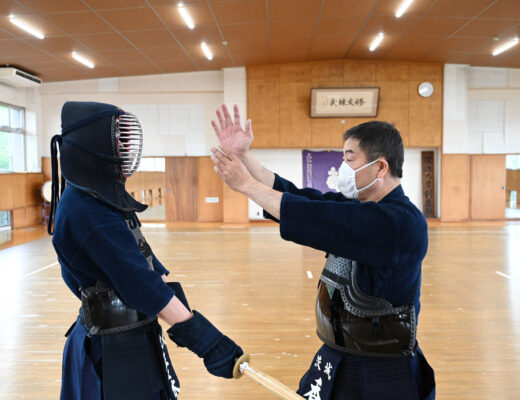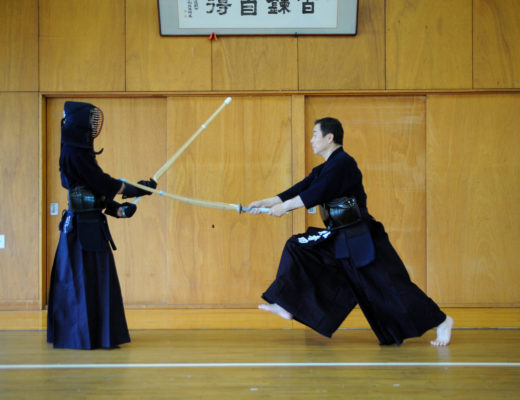2024.8 KENDOJIDAI
Photography = Nishiguchi Kunihiko
Composition = Tsuchiya Tomohiro
Translation = Sato Mariko, Pepijn Boomgaard
The ‘Ideal Kamae’ enables effective Kizeme (*). To create such Kamae, the proper positioning of the left fist and correct use of footwork are crucial. With clear and precise theory, Koda Kunihide Sensei, who has trained numerous renowned Kenshi, provided insights into the key elements of Kizeme and the Kamae that lead to effective strikes in actual matches.
*Kizeme
The act of overwhelming the opponent with energy bursting out from within one’s mind; attacking not with one’s movement but with a strong spirit to strike or thrust. (Quoted from the Japanese-English Dictionary of Kendo)
Koda Kunihide, Hanshi 8th Dan

Born in Nagasaki Prefecture in 1957. After graduating from Nagasaki Higashi High School, he went on to the University of Tsukuba, and after teaching at a high school in Nagasaki Prefecture, he became a teacher at his alma mater, the University of Tsukuba. He has won the third place in the All-Japan Kendo Championship, took the individual title in the World Kendo Championships, and the National Teachers’ Kendo Championship, among others. In 2023, retired from the University of Tsukuba. Currently serving as a permanent director of the All Japan Kendo Federation and as the head instructor of the Seijo Gakuen Kendo Club. Holds the title of Professor Emeritus at the University of Tsukuba.
The Importance of Preparation for a Dignified Posture
To create an “Ideal Kamae,” it is essential to first cultivate a dignified standing posture. The ideal is to exude a sense of strength and readiness to face your opponent with a composed and respectful demeanor from the very start. As a prerequisite, careful attention must be given to your attire. Pay close attention to the proper wearing of your Kendo-gi, Hakama, Bogu, and Shinai, and strive for a correct and graceful standing posture.
It is also important to choose Kendo equipment that fits your body properly. Specifically, the position of the “monomi” in the Men should align with your eyes, allowing you to observe your opponent with “Enzan no Metsuke*”. If the Monomi is misaligned, it can lead to viewing your opponent from above or below, which detracts from a dignified standing posture. Moreover, when facing an opponent, this misalignment can cause you to lift or tuck your chin too much, resulting in a loss of core strength and an unstable posture during strikes. Additionally, the knot of the Men Himo should be positioned at the correct height, ensuring both proper alignment and an aesthetically pleasing appearance.
*Enzan no Metsuke
A term meaning it is important to look at the figure of the opponent as a whole rather than at a particular point, as if looking at a far away mountain. (Quoted from the Japanese-English Dictionary of Kendo)
Disrupt your opponent with Ki and seize the opportunity
A Kamae that pushes out your Ki first, enabling Kizeme, creates a sharpness in your Kensen that poses a threat to your opponent. When following the stages from Kizeme to striking, the process can be organized as: “prepare your Ki” → “harmonize with your opponent’s energy (Aiki)” → “building up your Ki” → “disrupt with Ki” → “seize the opportunity” → “strike.”
Putting these concepts into practice is challenging. While striking techniques can be learned through repeated training until the body naturally remembers them, attacking with Ki is intangible and not easily grasped in the same way. However, since it is a crucial aspect of Kendo’s core principles, I will begin by explaining it in words.
Even in Kizeme, preparation is crucial. It begins with properly facing your opponent, bowing, and calming and preparing your own Ki. Once you are in Kamae facing your opponent, enter Aiki. A simple way to understand achieving Aiki is to synchronize your breathing with your opponent’s.
It is common in exams or matches for one’s Kendo to change depending on the opponent. When you reach a state of Aiki with your opponent, both of you can bring out the best in each other. On the other hand, techniques executed before achieving Aiki often result in what’s called a “teuchi,” which, even if it hits, lacks impact. If you focus solely on your own will and fail to achieve Aiki, it is unlikely that you will succeed in high-level grading examinations.
It is important to reach a state of Aiki with the mindset of bringing out each other’s strengths and the aspects of yourself that you have worked hard on in regular Keiko. Keep in mind that techniques executed after fully expressing your Ki and achieving Aiki with your opponent are the ones that will impress the judges and earn you a decisive point.
At the stage of building up your Ki and disrupting with Ki, it is crucial to maintain a strong mindset with the attitude of, “If you’re coming, come; if not, I will go.” It is essential not to lose in spirit, and having your left fist in the correct position should lead to a successful Ki-based attack. On the other hand, if your left hand starts to move, it indicates that your opponent is influencing your spirit.
Furthermore, disrupting your opponent’s Ki means overcoming their spirit with your own, breaking their resolve before entering the Uchima(*). At the same time, by using the Shinogi and taking the center with your sword tip, you also neutralize their sword, and as a result, you neutralize their technique—this is the teaching of the “Three Killing Methods” (San-sappo). In an exam, all the judges are observing this process. If you can execute a strike that follows these steps, you should naturally pass the exam.
*Uchima
One’s optimum distance and opportunity for striking the opponent. (Quoted from the Japanese-English Dictionary of Kendo)
Finally, let’s discuss the mindset required before entering the striking distance. It is important to consistently practice attacking with your spirit from Shokujin no Maai (the distance where blades touch), aiming to strike with intent while controlling the opponent’s movements. Carelessly entering Koujin no Maai (the distance where blades cross) can lead to having your Kensen suppressed or countered. The ideal approach is to smoothly enter from Shokujin no Maai, exploiting the opponent’s Kyo (a state where their spirit or energy is not fully engaged). For those with quick reflexes, this transition into a strike is key. This principle applies equally in both examinations and matches.
As you age and focus more on close-range Keiko (Chika-Ma), it is easy to neglect this sense. It’s not necessary to always execute a strike, but it is important to maintain the awareness of attacking with Ki from a far distance (To-Ma), and being ready to capitalize on any movement your opponent makes by riding on it and executing a strike.
Key Points to Consider in Kamae
The rest of this article is only available for Kendo Jidai International subscribers!





